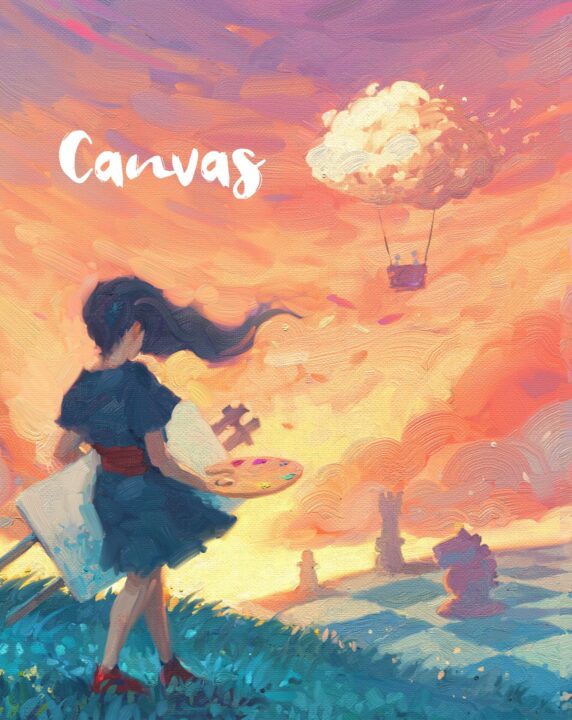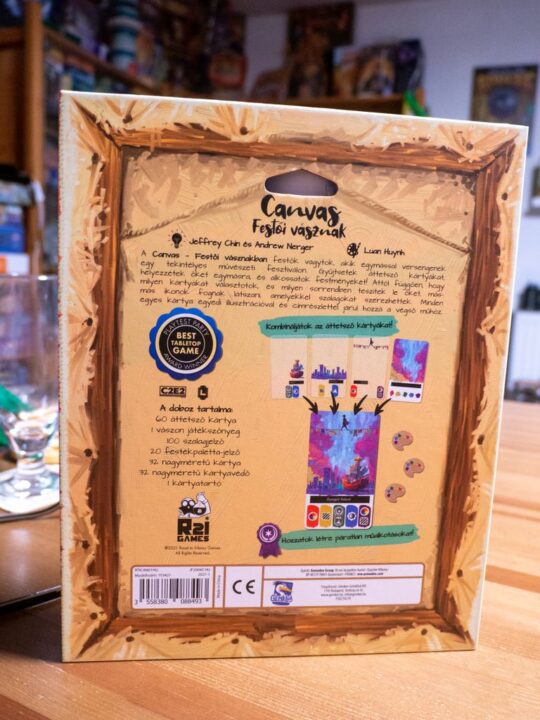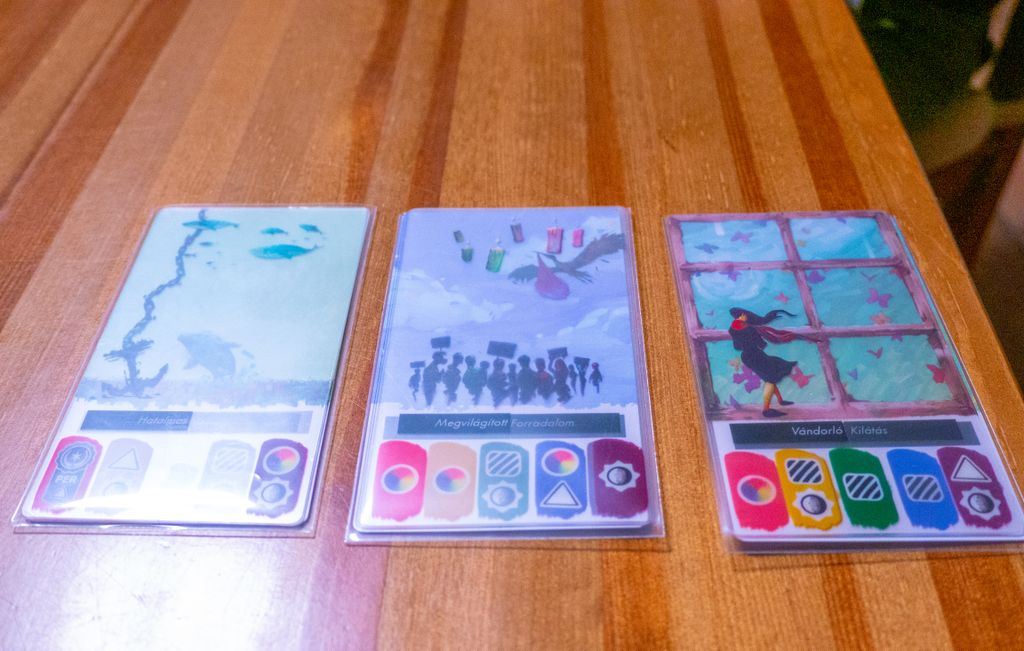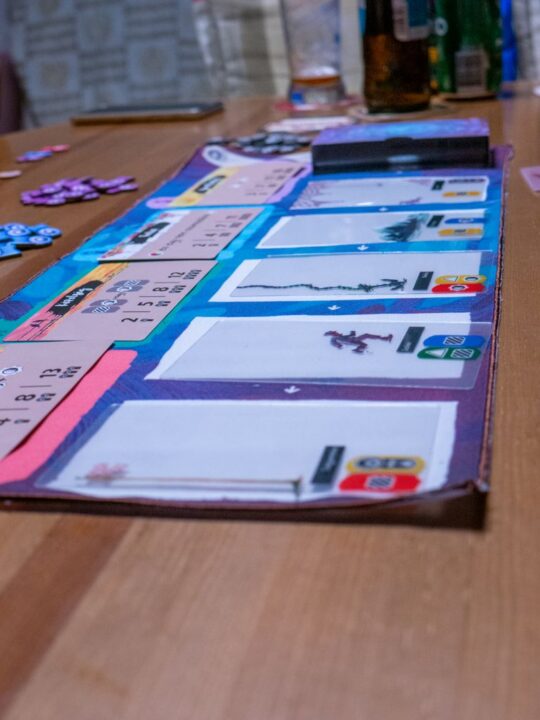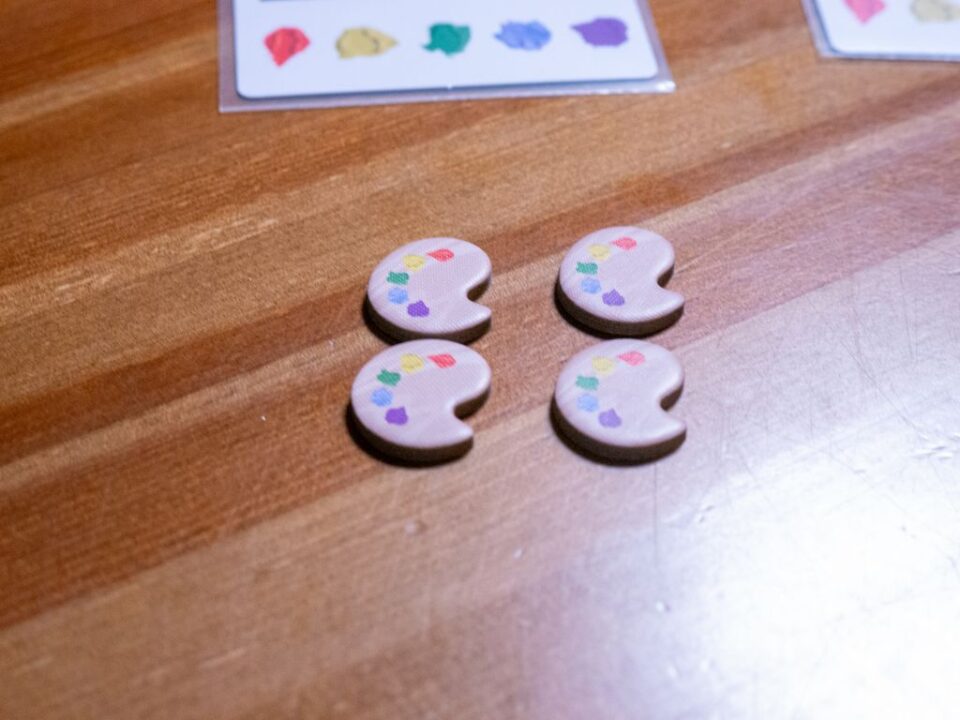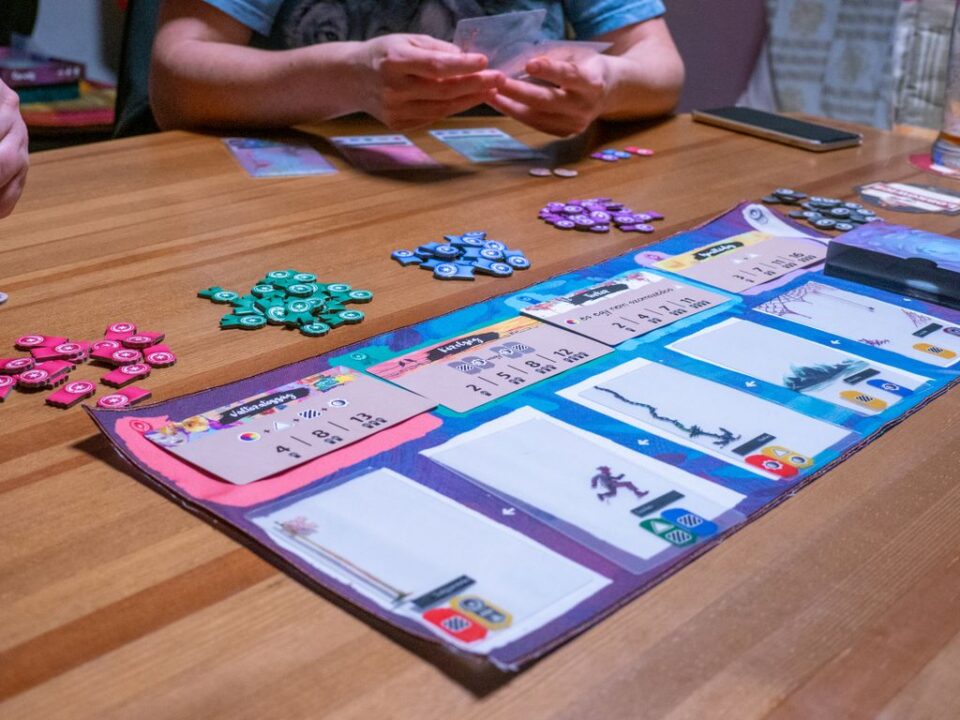Welcome to my review of Canvas! I gathered my friends, their snacks, and way too much excitement to see if this artsy game is really a masterpiece or just a pretty face. I’m here to give you the honest scoop—no paint-by-numbers fluff—so you can decide if this game should hang out on your shelf. Expect plenty of laughs, a few groans (from the rules, not the snacks), and a real look at what makes Canvas shine, or smudge.
How It Plays
Setting up
First, lay out the scoring cards and the row of art cards. Everyone grabs a blank canvas and three sleeved background cards. Put the ribbons nearby. You’re basically sitting in a circle pretending to be Bob Ross, minus the perm.
Gameplay
On your turn, you pick a transparent art card and pay inspiration tokens if you want to skip cards. Then, you slide that card on your canvas sheet. You stack up to three to make a painting. Each card has icons—these matter for scoring. It’s a bit like making a sandwich: just less messy and no regrets.
Winning the game
Once you’ve made three paintings, the game ends. You check how many ribbons you earned by matching icons to the scoring cards. Whoever has the most ribbons wins and gets to brag about being the real artist. The others just have to accept that maybe their creativity peaked in kindergarten.
Want to know more? Read our extensive strategy guide for Canvas.
Art That Belongs in a Museum (But You Can Also Shuffle It)
Let’s talk about the thing that literally makes ‘Canvas’ pop: the art and those jaw-dropping components. If you haven’t seen this game on a table yet, picture this: you’re surrounded by friends, but nobody’s making eye contact because they’re all gazing lovingly at the dreamy, layered artwork they’ve just created. The main hook in Canvas is the transparent art cards. Each one has bits of illustration—sometimes bold, sometimes subtle—that overlay to form a complete painting as you slide them into your canvas sleeve. It sounds simple, but setting up your masterpiece for the first time legit made me giddy, and that’s not just because I hadn’t had my coffee yet.
Component quality? Top notch. The painting sleeves are sturdy and slide the cards in without wrecking your fragile works of art. The cards are thick, with a finish that makes them feel special. That’s good, because you’ll handle them a lot during a game. The game board is small and unintrusive, which is great if (like me) you play on a table that’s mostly covered in old mugs and three kinds of snacks. Even the tokens are thick and chunky, like the potato wedges I eat between turns. Trust me, Canvas is a looker—this game could probably win a beauty contest at your family gathering.
If you’re a sucker for pretty games, Canvas is going to charm the socks off you. Now let’s get messy and talk about what really matters: how Canvas actually plays, and whether the rules made me want to flip the table or just quietly eat more snacks.
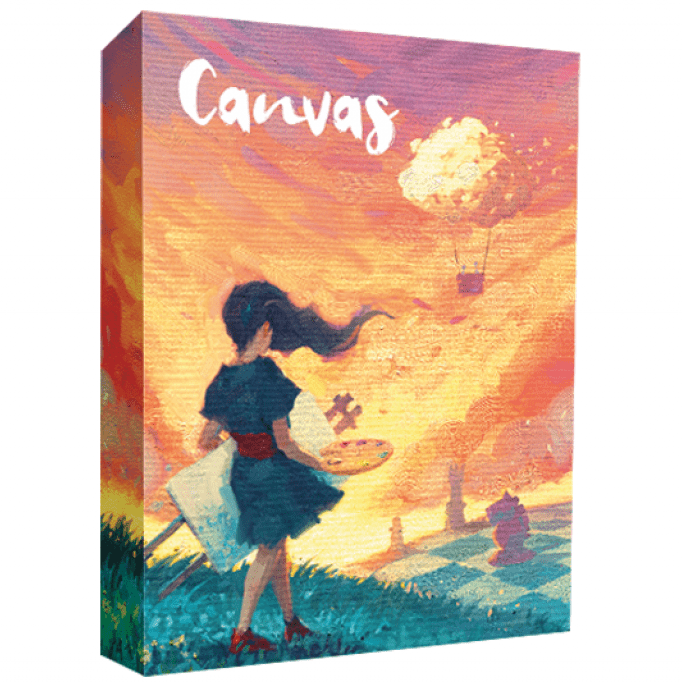
How Canvas Keeps You Creating: Game Mechanics and Rules Clarity
Let’s talk about the guts of Canvas—the stuff that actually makes the game tick. I’ve played more games than I’ve had hot dinners (and, yes, I eat a lot), but Canvas has something special. On your turn, you can either take an art card from the row or craft a painting using three cards from your hand. Sounds simple, right? That’s because it is! The rules come on a single sheet, and we understood them faster than I can eat a bag of chips.
But don’t let that fool you. The fun in Canvas isn’t just in picking pretty cards. It’s all about matching icons and backgrounds to meet the variable scoring goals. Those goals change every game and force you to actually think—sometimes, you even have to read. The transparent cards stack, which feels weirdly satisfying, and it’s not just for looks. The way you layer them decides your score, so there’s proper room for clever moves and not just luck. If you mess up, it’s your fault, not the game’s. That’s a big plus for me!
All in all, the rules are super clear with lots of helpful pictures. My friend Dave still managed to forget how to score, but that’s just Dave. There are barely any fiddly exceptions, which means the group stays focused and the game moves quickly. It’s almost like the rulebook was written by someone who actually likes their players.
If you think Canvas is just a peaceful art project, buckle up—the next section takes a wild brushstroke into player interaction and whether it’s got legs for replay, or if it’s just a one-and-done gallery piece.
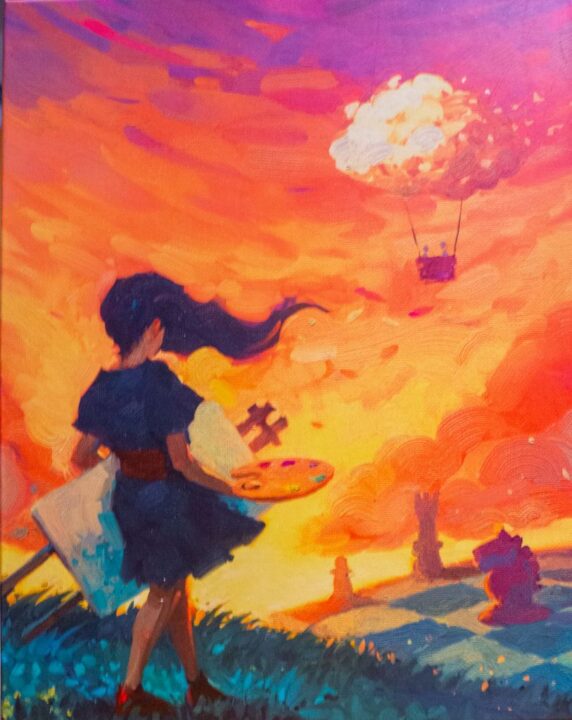
Player Interaction and Replayability in Canvas
Let’s talk about how Canvas brings people together, or not. If you’re looking for a game where you backstab your friends, yell at Aunt Linda, or flip the table in rage, you might want to keep walking. But if you love sizing up your opponents and trying to outsmart them as you paint your masterpiece, Canvas gives you just enough to chew on.
Interaction in Canvas is mostly about snatching that perfect art card before someone else grabs it. There’s this silent battle at the card market, where you see what others are collecting and wonder, “Is Sally REALLY going for all those purple ribbons, or is she trying to fake me out?” It’s a quiet tension, but it’s there. I, for one, have definitely stolen a card to mess with my pal Jim, all under the excuse of “artistic inspiration.” He still hasn’t forgiven me. Canvas makes you watch each other’s boards, but you’re never directly ruining someone’s day (unless you’re Jim, sorry buddy).
As for replayability, Canvas offers a good bit of it. The combinations of cards and scoring objectives change each game, so you never really paint the same masterpiece twice. I’ve played Canvas more times than I’ve repotted my cactus (and that’s saying something). The game stays fresh, even if you sometimes get a bit too attached to making the “quirkiest” painting over, you know, actually winning.
So, if you like light competition with a splash of creativity, Canvas delivers. But does it reward clever play, or is it just luck of the draw? Next up, let’s untangle that knot of fate and strategy!
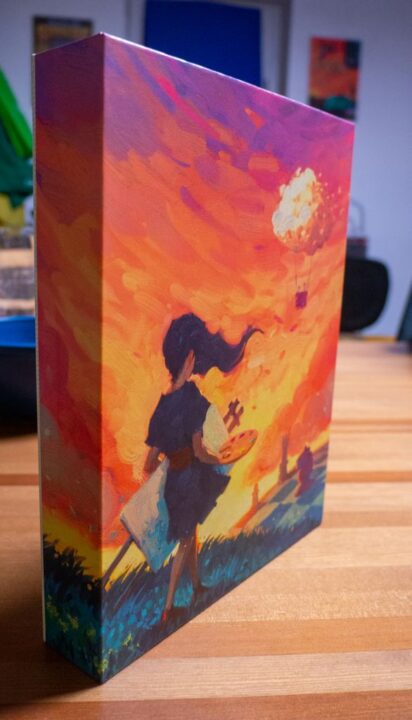
Canvas: A Battle Between Luck and Planning
Let’s talk about what every gamer asks: Is Canvas about clever moves, or just bumbling into victory because the cardboard gods smiled on you? I’ve played Canvas more times than I’ve lost my car keys (a lot). Luck is in the air, but not as much as I dreaded.
You never know which art cards will show up in the market, so there’s some randomness. Sometimes, my perfect background was stolen right before my turn. I’m not saying I flipped the table, but I considered it. Still, you can plan about 80% of your masterpiece. You have to watch the scoring rules and snatch up cards that match your vision and actually score you points.
There’s luck in the card draw, but you can see most of what’s coming and plan around it. Plus, using inspiration tokens to grab a further card can turn a bad market into a clever win. My friend Drew hoarded tokens, then swept in to grab the card I needed. I may never forgive him, but I did respect the strategy.
If you enjoy games that reward thinking ahead and don’t punish you for a single unlucky pull, Canvas is a safe pick. If you want pure skill, you might wish there was even less luck, but honestly, it keeps things fresh and funny. In short: for me, the balance works, and I recommend Canvas—unless you absolutely rage at luck, then maybe keep your paintbrushes wrapped up.

Conclusion
Alright, that’s a wrap on my Canvas review! This game wowed me with its pretty art and how clever you can get with layering. I love easy-to-learn rules, and Canvas nails it—no one in my group got lost, even after a snack break (or three). Player interaction is on the lighter side, but it doesn’t feel like multiplayer solitaire. Replayability? Oh yes, you’ll want to try new combos every round. The only downside is there’s a bit of luck with the card draw, which might bug you if you want full control. But honestly, it’s not a dealbreaker. If you like quick, strategic games with gorgeous looks, Canvas is worth space on your shelf—and maybe even on your wall. That’s it for this review, folks! Grab some friends and get painting!

